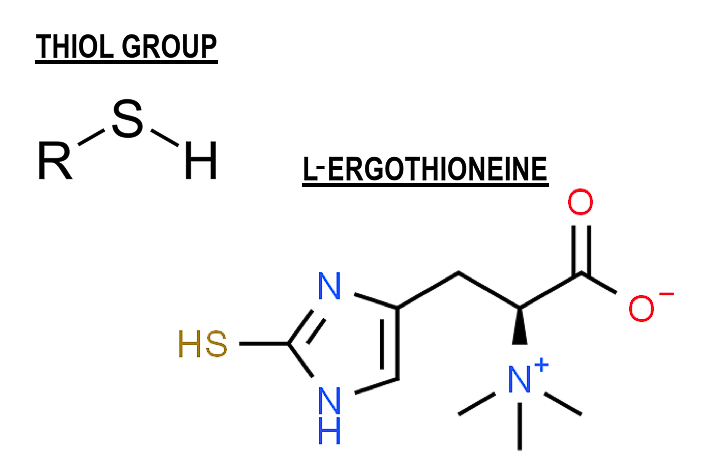MitoPrime L-Ergothioneine The Super Antioxidant

Aging is the progressive accumulation of changes with time. It’s the result of damage caused by free radicals and oxidative stress on the body, generating harm to the structures and functions of molecules, cells and organs of the body. These causes of aging can be the result of many processes, including oxidative stress,1 which is an imbalance between production and accumulation of something called reactive oxygen species (ROS) in cells and tissues and the ability of your body to detoxify these substances.
This progressive damage increases as we get older and is considered the general theory most scientists have of how and why we age. Thankfully, a diet and supplement plan that’s rich in micronutrients, antioxidants and phytonutrients can reduce and sometimes even reverse cellular damage.
One of those potential antioxidants that’s showing promise as a super antioxidant is L-ergothioneine. Before we get into how L-ergothioneine works and its benefits, we first need to discuss what antioxidants and free radicals are and why they’re so important to aging prevention.
What Are Antioxidants & Free Radicals?
 Antioxidants are substances that delay, prevent or remove oxidative damage to cells, molecules and organs of the body. Another definition is any substance—natural or man-made—that directly scavenges free radicals or indirectly acts to upregulate antioxidant defenses or inhibit free radical production.
Antioxidants are substances that delay, prevent or remove oxidative damage to cells, molecules and organs of the body. Another definition is any substance—natural or man-made—that directly scavenges free radicals or indirectly acts to upregulate antioxidant defenses or inhibit free radical production.
Free radicals are highly unstable molecules formed through oxidation or a rupture of its chemical bonds, making them free-floating reactive compounds. Although certain processes in the body produce and use free radicals, excess free radicals can interact with lipids, proteins and DNA, resulting in damage or oxidative stress. When the body can’t neutralize excessive free radicals, it can result in a chain reaction of damaging effects on the body.
Antioxidant activity can be effective through different ways, including interrupting propagation of the auto-oxidation chain reaction, as inhibitors of free radical oxidation reaction, as inhibitors of pro-oxidative enzymes, as reducing agents that convert hydroperoxides into stable compounds, by repairing protein, as metal chelators that convert iron and copper into stable products and as singlet oxygen quenchers.2
Identifying specific antioxidants for supplementation can therefore help neutralize free radical activity and help fight the aging process.
What Is L-Ergothioneine?
 L-ergothioneine (ET) is what scientists refer to as a “thiol” form of the natural amino acid histidine that can be considered a super-antioxidant compound. In fact, thiol-based antioxidants are considered the most powerful antioxidants found in nature. One of the most common thiol-based compounds you’ve likely heard of is glutathione.
L-ergothioneine (ET) is what scientists refer to as a “thiol” form of the natural amino acid histidine that can be considered a super-antioxidant compound. In fact, thiol-based antioxidants are considered the most powerful antioxidants found in nature. One of the most common thiol-based compounds you’ve likely heard of is glutathione.
L-ergothioneine is naturally present in the body and has been associated with aging. Plasma L-ergothioneine levels continue to decline in elderly populations, as evidenced in epidemiological studies done in Asia and Australia, which showed that L-ergothioneine was inversely correlated with age.3 This decline in blood L-ergothioneine could be because of a few factors such as increased cell turnover, diet changes or altered ergothioneine transporter function (ETT). This suggests that lower blood levels of L-ergothioneine are a risk factor for age-related disorders and promote health and longevity.
Although L-ergothioneine can be obtained from the diet and is found in plants and foods such as mushrooms, black beans, red meat, king crab, rye, pork, chicken, and oats, supplementation with L-ergothioneine could have a far more profound effect on supporting healthy aging.
Structure & Function of L-Ergothioneine
 Chemically speaking, L-ergothioneine is a tautomeric, which is a structural isomer that readily interconverts between forms. L-ergothioneine exists in the thione form, which makes it more resistant to oxidation, unlike the super-antioxidant glutathione, which is rapidly oxidized. L-ergothioneine can scavenge ROS (reactive oxygen species), RNS (reactive nitrogen species) and even RCS (reactive chlorine species) protecting cells from damage.4
Chemically speaking, L-ergothioneine is a tautomeric, which is a structural isomer that readily interconverts between forms. L-ergothioneine exists in the thione form, which makes it more resistant to oxidation, unlike the super-antioxidant glutathione, which is rapidly oxidized. L-ergothioneine can scavenge ROS (reactive oxygen species), RNS (reactive nitrogen species) and even RCS (reactive chlorine species) protecting cells from damage.4
In the body, L-ergothioneine is concentrated in cells and tissues frequently exposed to oxidative stress. It has also been shown that there are specific transporters for L-ergothioneine in the body, with abundant levels in tissues.5 ETT moves L-ergothioneine throughout the body via the blood, storing it in locations that are high in free radical activity. Cells lacking ETT are more susceptible to oxidative stress, resulting in increased mitochondrial DNA damage, protein oxidation, cytokine inflammatory response and lipid peroxidation.5 L-ergothioneine therefore acts as a strong antioxidant and anti-inflammatory compound. Additionally, it prevents lipid peroxidation and protects both mitochondria and DNA.
 L-ergothioneine also acts as a senolytic, which destroys senescent cells in old tissues in order to rejuvenate them, turning back the progression of age-related conditions. Senescent cells accumulate in many tissues with aging. L-ergothioneine works by clearing out damaged and dying cells that are just taking up space.
L-ergothioneine also acts as a senolytic, which destroys senescent cells in old tissues in order to rejuvenate them, turning back the progression of age-related conditions. Senescent cells accumulate in many tissues with aging. L-ergothioneine works by clearing out damaged and dying cells that are just taking up space.
Benefits of L-Ergothioneine
 High Antioxidant Capacity
High Antioxidant Capacity
L-ergothioneine has been found to have higher antioxidant capacity than many other common antioxidants. Here's how L-ergothioneine (MitoPrime) stacks up:
- Eliminates the deadliest radical, singlet oxygen, up to 7,500% better than any antioxidant known today.
- Eliminates all oxidants up to 3,400% better than glutathione.
- Inhibits lipid peroxidation 270% better than CoenzymeQ10.
- MitoPrime’s half life is 4,500 times longer than glutathione, 268 times longer than polyphenols and flavonoids while being 18 times longer than Vitamin C.
DNA Protection
L-ergothioneine has been shown to help prevent free-radical-induced  DNA damage by eliminating ROS, RNS and the two DNA-destroying acids hypochlorous and hypobromous, both of which are considered reactive chlorine species (RCS). Most antioxidants cannot protect against RCS.
DNA damage by eliminating ROS, RNS and the two DNA-destroying acids hypochlorous and hypobromous, both of which are considered reactive chlorine species (RCS). Most antioxidants cannot protect against RCS.
RCS is a strong free radical that attacks mitochondrial DNA, producing mutagenic DNA lesions. These lesions can alter the DNA, resulting in wrong DNA encoding and messaging, producing the wrong proteins. L-ergothioneine can not only scavenge RCS but also help provide some protection and assist in repair of both nuclear and mitochondrial DNA.
One in vitro study showed that exposure of human-derived cells to L-ergothioneine protects mitochondrial DNA from oxidative stress when ETT isn’t expressed.5 L-ergothioneine treatment effectively prevented free-radical-induced DNA damage in a dose-dependent manner. When ETT was removed, L-ergothioneine-treated cells yielded much higher viability rates—a 40 percent increase—than those without treatment. L-ergothioneine can directly protect against DNA damage, intercepting damage induced by UV radiation before it can negatively affect cells. The ETT location therefore helps transport L-ergothioneine to defend against substances that could damage it, protecting cellular integrity.
Anti-Inflammatory Support
In addition to L-ergothioneine’s antioxidant capacity, L-ergothioneine also  has anti-inflammatory properties. L-ergothioneine has been shown to inhibit numerous pathways of inflammation, including pro-inflammatory cytokines, interleukin-6 (IL-6) and IL-8, myeloperoxidase (MPO) and NfKappaB.
has anti-inflammatory properties. L-ergothioneine has been shown to inhibit numerous pathways of inflammation, including pro-inflammatory cytokines, interleukin-6 (IL-6) and IL-8, myeloperoxidase (MPO) and NfKappaB.
Multiple studies in vitro cell models have shown that L-ergothioneine can modulate levels of inflammatory cytokines and mitigate oxidative damage. In studies on mice, it was shown that L-ergothioneine provided protection against acute lung injury brought on by cytokines.6
In another study on mice exposed to cigarette smoke for six months, with elevated numbers of inflammatory cells in the lungs and increased inflammatory cytokines, those with knocked-out ETT had more severe reactions.7 Cells that express ETT accumulate higher levels of L-ergothioneine.
Skin Health & Immunity
 In addition to L-ergothioneine’s many benefits listed above, L-ergothioneine has also been found to have numerous longevity effects, including protecting skin cells against UV radiation, modulating cytokine inflammation linked to diseases, and immunomodulating effects by upregulating ETT expression and L-ergothioneine availability.
In addition to L-ergothioneine’s many benefits listed above, L-ergothioneine has also been found to have numerous longevity effects, including protecting skin cells against UV radiation, modulating cytokine inflammation linked to diseases, and immunomodulating effects by upregulating ETT expression and L-ergothioneine availability.
Eye Health & Neurogenesis
L-ergothioneine is present in the eye and may help protect against  oxidative damage, whereas lower L-ergothioneine levels might predispose people to certain eye disorders such as cataracts. L-ergothioneine can also accumulate in the brain and provide protection against oxidative damage and neuroinflammation. It can also provide protection against toxic amyloid accumulation and even promote neurogenesis. L-ergothioneine levels have also been correlated with the prevalence of neurodegenerative diseases of aging.8
oxidative damage, whereas lower L-ergothioneine levels might predispose people to certain eye disorders such as cataracts. L-ergothioneine can also accumulate in the brain and provide protection against oxidative damage and neuroinflammation. It can also provide protection against toxic amyloid accumulation and even promote neurogenesis. L-ergothioneine levels have also been correlated with the prevalence of neurodegenerative diseases of aging.8
Cardiovascular Support
 It’s also been shown to have some cardiovascular protective benefits. In a study associating changes in blood metabolites with cardiometabolic diseases in 3,236 subjects, higher blood L-ergothioneine had the most significant association with lower risk of cardiometabolic disease.9
It’s also been shown to have some cardiovascular protective benefits. In a study associating changes in blood metabolites with cardiometabolic diseases in 3,236 subjects, higher blood L-ergothioneine had the most significant association with lower risk of cardiometabolic disease.9
MitoPrime (L-Ergothioneine) from NNB Nutrition
 MitoPrime is NNB Biotech’s bio-perfected form of the histone derivative L-ergothioneine. This may be considered “the longevity vitamin,” because once it’s in the body, it’s available to be shuttled to wherever it’s needed to protect against free radical damage. However, despite how effective this antioxidant is, it cannot be manufactured by the body. Although certain foods like pork, king crab, mushrooms, and rye can provide a source of L-ergothioneine, the dosage is so low in these foods that supplementation is the only practical method of getting sufficient quantity. Supplementation provides a concentrated form with a consistent dose.
MitoPrime is NNB Biotech’s bio-perfected form of the histone derivative L-ergothioneine. This may be considered “the longevity vitamin,” because once it’s in the body, it’s available to be shuttled to wherever it’s needed to protect against free radical damage. However, despite how effective this antioxidant is, it cannot be manufactured by the body. Although certain foods like pork, king crab, mushrooms, and rye can provide a source of L-ergothioneine, the dosage is so low in these foods that supplementation is the only practical method of getting sufficient quantity. Supplementation provides a concentrated form with a consistent dose.
Enter NNB Nutrition’s MitoPrime, an ultra-premium form of L-ergothioneine. It’s extracted using a patented technology to produce a highly bioavailable L-isomer form of ergothioneine that is 100 percent pure and all natural, with GRAS status approval from the FDA. We know of no other ingredient manufacturer in the world that’s capable of producing a more pure form of L-ergothioneine than NNB Nutrition’s MitoPrime branded form of this super antioxidant.
MitoPrime (L-Ergothioneine) Dosage
 As for dosage, it has been proposed that L-ergothioneine consumption from the diet is roughly 17 milligrams per day. Consider introducing MitoPrime L-ergothioneine into your supplement stack by using a daily dose of 5 to 10 milligrams taken 1 to 3 times per day. This works out to a daily dose of 5 to 30 milligrams, depending on your needs. Daily dosages within this range provide all the benefits that MitoPrime has to offer.
As for dosage, it has been proposed that L-ergothioneine consumption from the diet is roughly 17 milligrams per day. Consider introducing MitoPrime L-ergothioneine into your supplement stack by using a daily dose of 5 to 10 milligrams taken 1 to 3 times per day. This works out to a daily dose of 5 to 30 milligrams, depending on your needs. Daily dosages within this range provide all the benefits that MitoPrime has to offer.
MitoPrime can be found in several new health and wellness products stacked with other antioxidants or used on its own. In terms of healthy aging, we believe L-ergothioneine will be the biggest supplement breakthrough of the decade. For more information on MitoPrime by NNB Nutrition, visit nnbnutrition.com.
 If you want more information on this ingredient, or any other ingredients from NNB Nutrition visit nnbnutrition.com.
If you want more information on this ingredient, or any other ingredients from NNB Nutrition visit nnbnutrition.com.
References
- Liochev SI. Which is the most significant cause of aging. Antioxidants. 2015. 4(4): 793-810.
- Sotler R. Prooxidant activities of antioxidants and their impact on health. Acta Clin Croat. 2019. 58(4): 726-36.
- Sotgia S, et al. Clinical and biochemical correlates of serum L-ergothioneine concentrations in community-dwelling middle-aged and older adults. PloS One. 2014. 9(1).
- Halliwell B, et al. Ergothioneine an adaptive antioxidant for the protection of injured tissues? A hypothesis. Biochem Biophys Res Commun. 2016. 470: 245-50.
- Paul BD, Snyder SH. The unusual amino acid L-ergothioneine is a physiologic cytoprotectant. Cell Death Differ. 2010. 17(7): 1134-40.
- Repine JE, et al. Effect of ergothioneine on acute lung injury and inflammation in cytokine insufflated rats. Prev Med. 2012. 54(Suppl). S79-82.
- Ehrhardt C, et al. Protective role of ergothioneine from tobacco smoke-induced oxidative stress in vitro and in vivo. FASEB J. 2016. 30(S1). 982.1-982.1
- Beelman RB, et al. Micronutrients and bioactive compounds in mushrooms: a recipe for healthy aging? Penn State. Lippincott Williams and Wilkins. 2019.
- Smith E, et al. Ergothioneine is associated with reduced mortality and decreased risk of cardiovascular disease. Heart. 2020. 106(9): 691-7.

